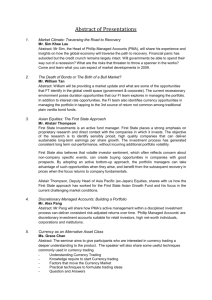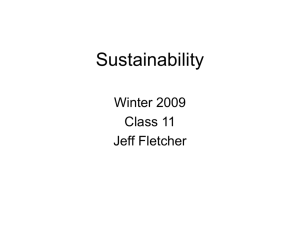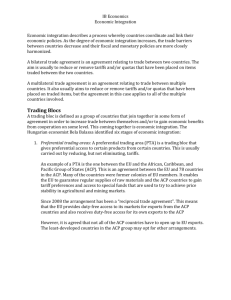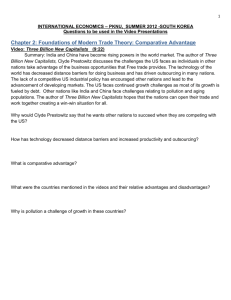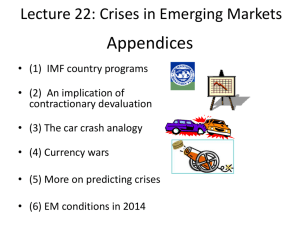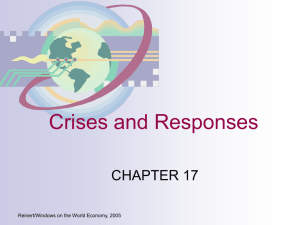INTERNATIONAL BURCH UNIVERSITY FACULTY OF
advertisement
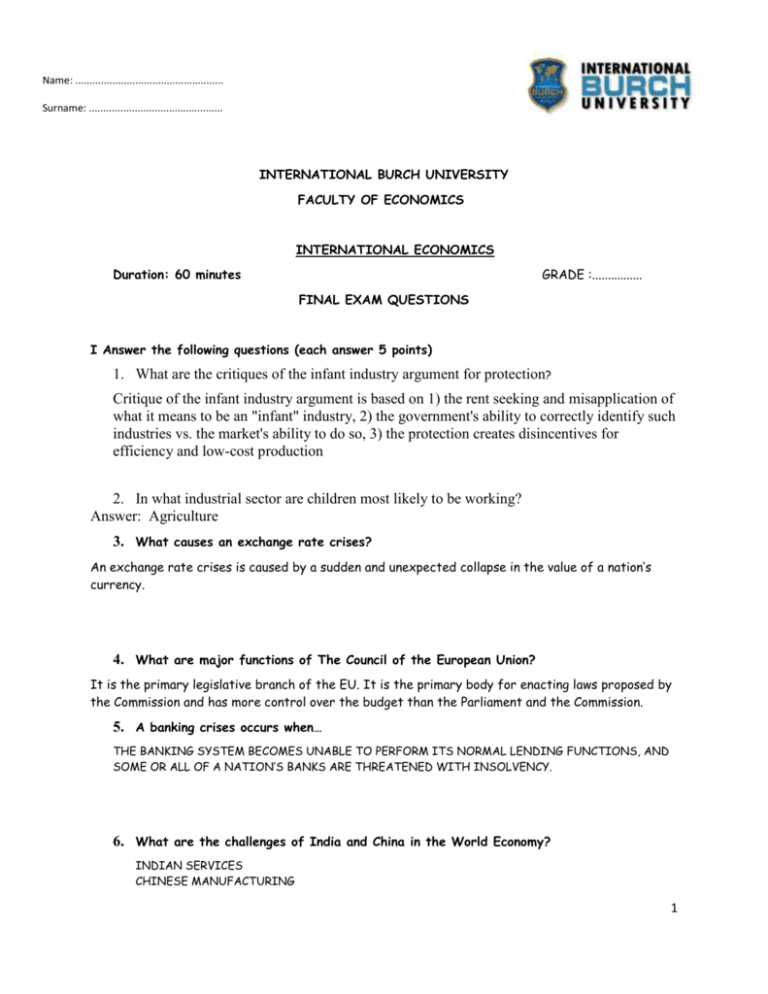
Name: .................................................... Surname: ............................................... INTERNATIONAL BURCH UNIVERSITY FACULTY OF ECONOMICS INTERNATIONAL ECONOMICS Duration: 60 minutes GRADE :................ FINAL EXAM QUESTIONS I Answer the following questions (each answer 5 points) 1. What are the critiques of the infant industry argument for protection? Critique of the infant industry argument is based on 1) the rent seeking and misapplication of what it means to be an "infant" industry, 2) the government's ability to correctly identify such industries vs. the market's ability to do so, 3) the protection creates disincentives for efficiency and low-cost production 2. In what industrial sector are children most likely to be working? Answer: Agriculture 3. What causes an exchange rate crises? An exchange rate crises is caused by a sudden and unexpected collapse in the value of a nation’s currency. 4. What are major functions of The Council of the European Union? It is the primary legislative branch of the EU. It is the primary body for enacting laws proposed by the Commission and has more control over the budget than the Parliament and the Commission. 5. A banking crises occurs when… THE BANKING SYSTEM BECOMES UNABLE TO PERFORM ITS NORMAL LENDING FUNCTIONS, AND SOME OR ALL OF A NATION’S BANKS ARE THREATENED WITH INSOLVENCY. 6. What are the challenges of India and China in the World Economy? INDIAN SERVICES CHINESE MANUFACTURING 1 AND DEMAND FOR RESOURCES 7. Why using trade barriers to enforce labor or environmental standards may be less efficient than other measures? First, imposing trade barriers is very costly. They create deadweight losses in consumption and production at home. Second, only large countries, if any at all, could use trade barriers successfully to stop the offending country. Moreover, imposing trade barriers may make conditions worse rather than better, since some producers may move their facilities into the informal sector of the economy. Third, there is also the borderline between protectionism and concern. Fourth, since child labor laws are vague and vary according to the income level of each country, there is no international agreement for universal child labor laws. Last but not least, the use of trade barriers may lead to retaliation and larger trade wars, which could be very costly to all countries involved. 8. What are environmental concerns in China China has 16 out of 20 most polluted cities in the world. 90% of ground water is contaminated. 200 mil. People in last decade moved to the city and live in poor conditions. One of the top contributors to the production of carbon dioxide, a major cause of global warming. 9. Define non-transboundary environmental impact? Impact that do not cross national borders. 10. Describe National Security Argument and give examples? Every nation protects some industries as a way to guard its national security. Military industry for example. II Choose the correct answer (each question 3 points) One reason why consumers are unlikely to be too upset about tariffs is because A) most consumers benefit from protection. B) tariffs are an inexpensive way to create jobs. C) consumer losses are not real losses. D) the costs are so spread out that no one pays a big share of the total. E) the gains of producers are larger. Answer: D Harmonization of standards refers to A) the elimination of tariffs and quotas by trading partners. 2 B) common product safety, environment, labor, and fair competition standards agreed upon by trading partners. C) the acceptance or keeping of a trading partner's standards as valid and sufficient by another trading partner. D) separate standards held by different trading partners which other partners refuse to recognize. E) All of the above. Answer: B Countries that compete by offering foreign firms a reduced set of environmental compliance requirements are known as A) transboundary members. B) pollution havens. C) pollutants. D) pollution exporters. E) pollution guards. Answer: B An exchange rate crisis is caused by A) a sudden and an unexpected collapse in the value of a nation's currency. B) the inability of the IMF to predict the immediate collapse of the currency of a country. C) the adoption of a flexible exchange rate system by a country or group of countries. D) the adoption of a fixed exchange rate system by a country or group of countries. E) Both C and D are correct. Answer: A . The international institution that serves as a lender of last resort is called the A) IBRD. B) WTO. C) IMF. D) World Bank. E) GATT. Answer: C III Write an essay (min 200 words) (35 points) Describe the criteria for membership in the European Union. Given the criteria, what are some of the major challenges with expanding the EU eastward? What are the potential problems of Turkey joining the EU? 3




